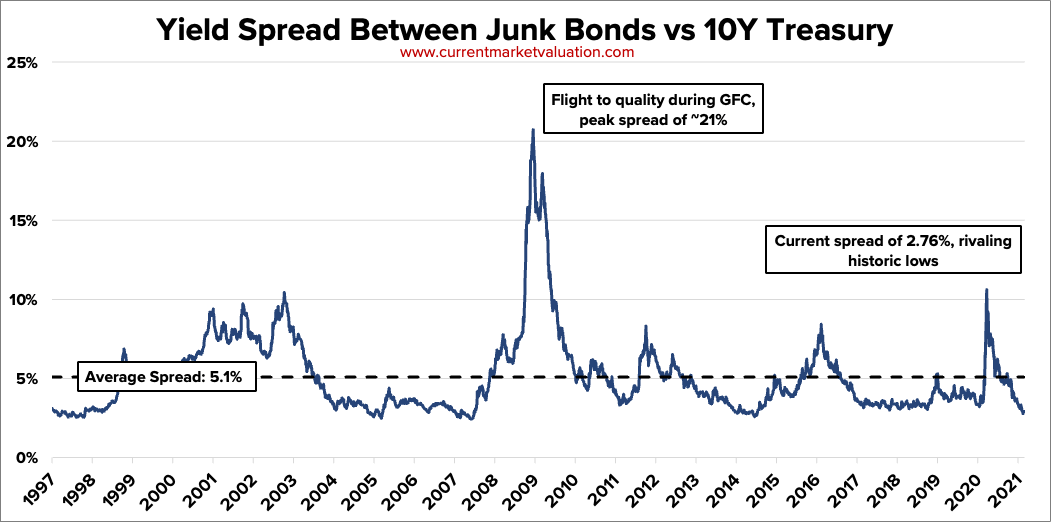
Overview
Junk bonds are bonds rated below BBB and are considered non-investment grade, i.e., you shouldn't invest in them unless you're very comfortable with the prospect of losing that money. For institutional investors who look primarily to safeguard cash rather than use it as a profit center (e.g., corporations, endowments, trusts, pensions, municipalities), the idea of taking on losses isn't acceptable.
The below chart shows the recent history of junk bond rates (red), compared to the 10 Year US Treasury rate (in blue, considered to be risk free as it is backed by the full faith and credit of the US government).

Worth Noticing
- Junk Bond rates are historically low, around 4%. This is less than half of the historical average rate (around 9%).
- Junk bonds (like most other interest rates) tend to spike with general market instability. In the early 2000's rates rose after the tech bubble popped. The Financial Crisis of '08 was a crisis of credit quality, where most investors moved away from risky asset classes and drove rates for junk bonds to their peaks (around 25%, clipped in the chart above).
- The coronavirus crash early last year drove a similar spike, briefly doubling junk rates from 5% to 11% during the heavy uncertainty heading into the pandemic recession.
Why?
Why are junk bond rates so low?
- Possibly fundamentals? Investors might currently be optimistic. Coronavirus is on the way out, vaccine distribution rates are great, and consumers who have been stuck at home for 12 months are ready to go out and spend in Q3/Q4. We might see unprecedented economic growth in the next year. So investors in junk bonds might be thinking that the bonds aren't really as risky as others may think, and are piling in, which is driving rates lower. Alternately...
- Cash has no where else to go. Because the Fed has been keeping interest rates so low via monetary policy & quantitative easing, investors seeking a minimum level of return necessarily need to go further out on the credit curve. Pension funds that need to target 5% return used to be okay with a mix of sovereign debt and government agencies, now they might need to pickup some lower rated bonds in their portfolio to juice the returns back up to what they're used to. This increased demand lowers the rate.
What's Next?
Below is the same data as above, just graphing the spread between junk and the 10Y treasury.

This shows the historic spread between junk bonds and 10Y Treasury bonds. We're currently at ~2.7%, versus historical average of about 5%. It seems clear that in the next few years, either 10Y Treasuries will flatten further (though there is hardly anywhere left for them to go), or junk bonds rates will necessarily need to rise.
Data Sources
The below table cites all data and sources used in constructing the charts, or otherwise referred to, on this page.
